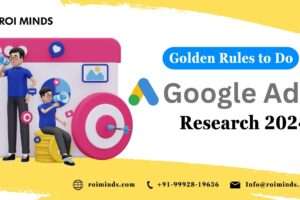Even though text ads are heavily text-based on the surface, there is much more going on behind the scenes that can make or break your success in the paid search space. Assuming your paid search campaigns are already up and running, we’ll go over five ways to take them to the next level.
- Negative Keywords
- Ad Rotation
- Automated Bidding
- Data-Driven Attribution
- Testing
1. Negative Keywords
Negative keyword lists are something that is frequently overlooked or undermanaged. If you have a broad match term like “+best +watches,” you might be surprised to learn how much of your search volume is unrelated to your business and how it affects the overall performance of your campaign. If your company only sells adult men’s watches, you’ll be disappointed to see that many of your impressions are for children’s or women’s watches. There are two main reasons why negative keywords are particularly useful.
- The main reason is that you will be wasting money on clicks that will not convert for you, such as someone clicking on your ad looking for a kid’s watch and discovering that you don’t sell any.
- The second reason is that it will harm the campaign’s overall performance and may lower your quality score.
The quality score comprises three components: expected CTR, landing page experience, and ad relevance. If you show up for an ad when you don’t have the product or service that the customer is looking for, they will either not click (CTR) or quickly leave your site (landing page experience), both of which can hurt your quality score. We generally recommend reviewing your search query reports at least once or twice a month to identify any new negative keywords that should be added. If you haven’t updated your negative keyword lists in a while, doing so will almost certainly benefit your campaign in terms of cost savings and improved quality scores. To learn more, read our article on Negative Keywords.

2. Ad Rotation
Ad copywriting is an art form in and of itself, but thankfully, Google and other ad platforms have tools to assist you in optimizing your creative strategy. Your current ad groups may contain one or two ads that have not been updated in a long time. In general, updating your ad copy may be a good idea, but switching to ad rotation optimization may pay off even more in the long run.
Assume we have two ads in our ad group, each with 500 impressions per month, but one outperforms the other in clickthrough rate and conversion rate. While we could disable the poorest-performing ad, doing so for all of our ad groups would be time-consuming, which is where ad rotation optimization comes in. This Google Ads setting allows Google to rotate between multiple ads to automatically find the best frequency for each ad.
In our two-ad scenario, Google may decide to show the better ad 75 percent of the time and the other ad 25 percent of the time to improve the ad group’s overall performance. You can also use this automation tool to test more than two pieces of ad copy. You can experiment with 3 or 4 ads and see how they perform, knowing that ad rotation will also optimize overall performance.
Ad rotation optimization can alleviate much of the burden of constantly managing ad copy and regularly testing more ad copy pieces. To begin using this feature right away, toggle ad rotation optimization at the ad group or campaign levels.
3. Automated Bidding
Another fantastic automation feature provided by Google and other ad platforms is automated bidding. It can be extremely difficult to determine the appropriate bids for each keyword in your account. Manual bidding can be suboptimal when dealing with the ebbs and flows of competition and business cycles. Fortunately, automated bidding solutions exist to make our lives easier and our campaigns more profitable.
Google’s Smart Bidding, the automated bidding solution, enables you to optimize toward a variety of different goals based on your desired outcome. You can set your bids to increase site visits, impression share, conversions at a specific CPA, and other goals. If you choose to maximize conversions or another metric, make sure you have a budget in place to keep your spending in check.
To begin, it may be simpler to use Target CPA or Target ROAS to ensure that you are getting the desired return as you spend money. See
4. Data-Driven Attribution
Most people begin by setting up conversion tracking with a last-click method, which is probably a good place to start. Depending on the nature of your business, you may want to start exploring other types of attribution methodologies as you progress in paid search.
Assume you sell a high-priced item online, such as wedding rings, where a customer is likely to do a lot of research before purchasing, and you don’t expect the first search from that customer to result in a sale. The customer’s first search may be “best wedding rings,” and they may then browse various sites, including yours, but not make a purchase.
They decide that your offering was the best after visiting multiple sites and giving it some more thought, so they search for your brand and make a purchase on your site.
In a last-click world, you might dismiss your initial search ad as ineffective because it didn’t result in a sale, but you and I both know that if we hadn’t appeared for that initial search, the customer would never have learned about our brand and made the purchase. This is where other types of attribution can help.
Google provides a report and tool called Data-Driven Attribution, which allows you to compare conversion rates between the last-click methodology and Google’s data-driven methodology. To enable data-driven attribution, navigate to Tools > Conversions > Edit Settings > Attribution Model > Data-driven attribution. See Google’s Data Drive guide for more information.
5. Testing
Our first four suggestions were for a specific feature or function in the paid search arena. Nonetheless, our fifth recommendation is a broader one to improve the performance of your campaigns. The fifth suggestion is to test more in all aspects of paid search.
You will learn new things about your customers and new ways to optimize paid searches by testing different things in your account. While one type of ad or landing page may be more effective for one account, the opposite may be more effective for another. The only way to learn about your audience and business is to test.
You can use Google’s Draft & Experiments feature or whatever search tool you prefer to create tests. Larger tests should be run at least once a quarter, and smaller tests should be more frequently.

As previously mentioned, ad copy using ad rotation is an example of a smaller test that may run more frequently. Using ad rotation to test new ad copy is a low-fidelity method of continuously testing and improving your ad copy.
A landing page test is an example of a larger test that may necessitate the use of a tool like Drafts & Experiments because it necessitates more resources to create a new landing page, design the test, and launch the test.
Testing landing pages, ad copy, and audience lists, among other things, is an excellent way to gain new insights and propel your business forward.





